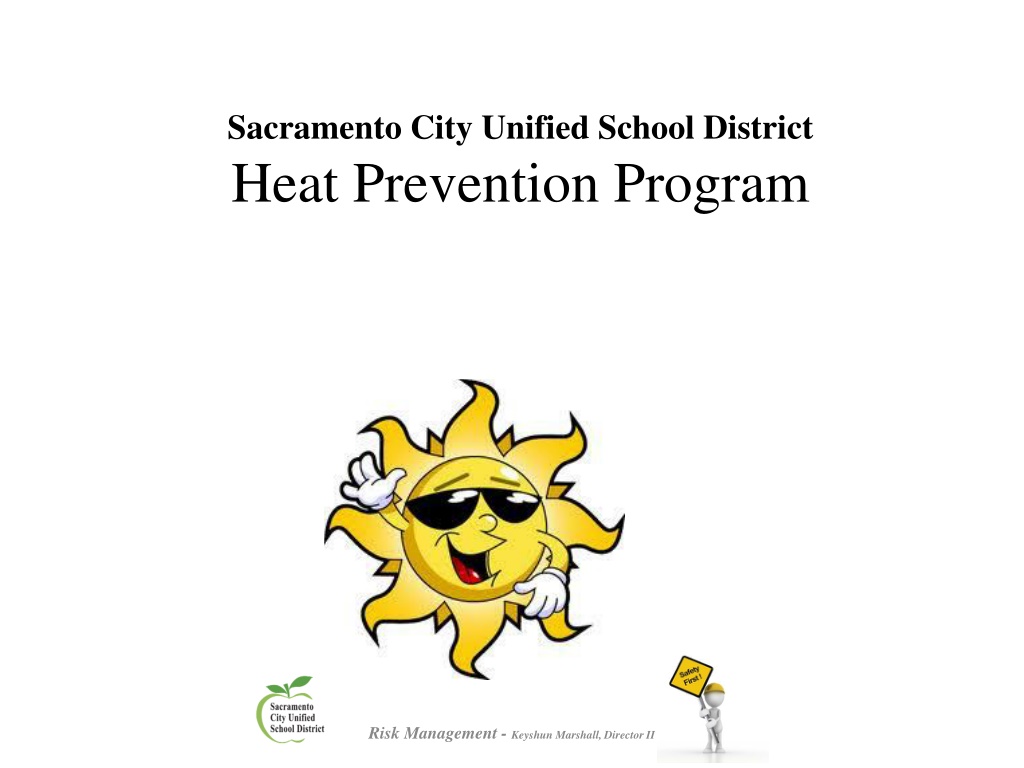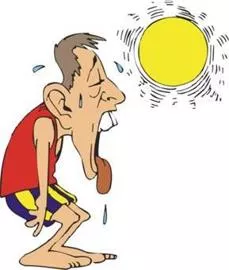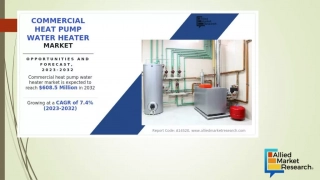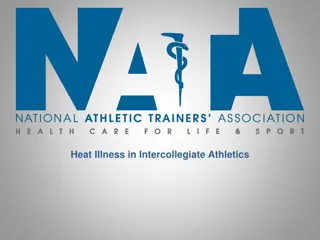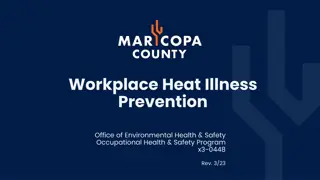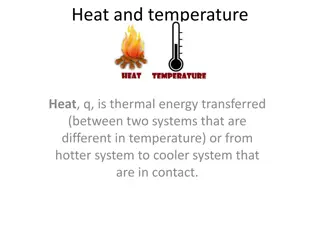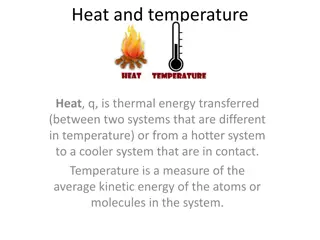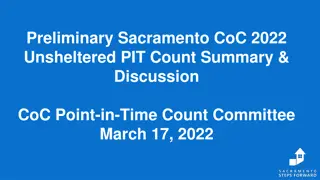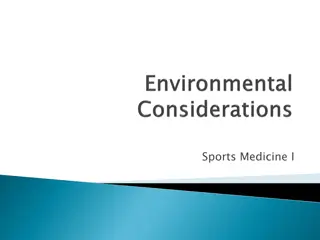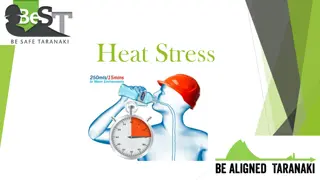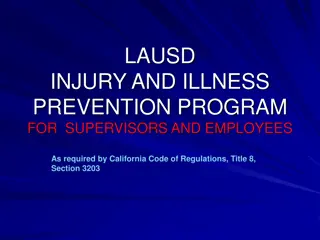Heat Illness Prevention Plan for Sacramento City Unified School District
This plan outlines key elements for preventing heat-related illnesses in the Sacramento City Unified School District. It focuses on providing access to water, shade, training, and emergency response to reduce the risk of heat-related illnesses among employees. The plan includes steps to ensure employees have access to potable drinking water, encourage frequent water breaks, provide shade for rest and cooling measures, and monitor water containers. By implementing these measures, the district aims to protect employees from the dangers of heat exhaustion and heat stroke.
Download Presentation

Please find below an Image/Link to download the presentation.
The content on the website is provided AS IS for your information and personal use only. It may not be sold, licensed, or shared on other websites without obtaining consent from the author. Download presentation by click this link. If you encounter any issues during the download, it is possible that the publisher has removed the file from their server.
E N D
Presentation Transcript
Sacramento City Unified School District Heat Prevention Program Risk Management - Keyshun Marshall, Director II
Heat Illness Prevention Elements Heat illness results when the body s internal temperature system is overworked. These procedures are designed to assist the district in reducing the risk of heat related illnesses and to ensure that emergency assistance is provided without delay.
Heat Illness Prevention Elements The elements reflected within this Heat Illness Prevention Plan are those contained in Title 8 of the California Code of Regulations, Section 3395 (T8 CCR 3395) and consist of the following: Provision of Water Access to Shade Training Response to an Emergency
Provision of Water Water is a key preventive measure to minimize the risk of heat related illnesses. According to regulation 3395 (c), employees shall have access to potable drinking. Where the supply of water is not plumbed or otherwise continuously supplied, water should be provided in sufficient quantity at the beginning of the work shift to provide one quart per employee per hour for drinking for the entire shift. Smaller quantities of water are allowed if effective procedures for replenishment during the shift are established to allow employees to drink one quart or more per hour.
Provision of Water To ensure access to sufficient quantities of potable drinking water and to encourage the frequent drinking of potable water, the following steps will be taken: Supervisor will provide repeated reminders to employees to drink frequently and more water breaks. Working water fountains will be available and within close proximity at most job sites.
Provision of Water Where water fountains are not easily accessible, supervisor/designee will provide water bottles. Supervisor/designated person will monitor water containers, and employees are encouraged to report to supervisor/designated person low levels or dirty water.
Access to Shade Access to rest and shade or other cooling measures are important preventive steps to minimize the risk of heat related illnesses.
Access to Shade Employees suffering from heat illness or believing a preventative recovery period is needed, shall be provided access to an area with shade that is either open to the air or provided with ventilation or cooling for a period of no less than five minutes. Such access to shade shall be permitted at all times.
Access to Shade To ensure access to shade and a preventative recovery period at all times, the following steps will be taken: During days of anticipated heat, jobs requiring outside exposure will be conducted early in the day. When a modified or shorter work-shift is not possible, more water and rest breaks will be provided. Indoor jobs where air conditioning is available will be conducted in the late morning or afternoon when the temperatures are higher.
Access to Shade Employees will be reminded regularly to take rest breaks in shaded and cooler areas. Supervisor will provide umbrellas, canopies or other portable devices for shade within 50 -100 yards of the work activity if other shade is not available. Drinking water will be available in shaded areas.
Extra Measures During Heat Waves Because of extreme environmental conditions during a heat wave, employees physical and mental condition can change rapidly into a serious medical condition.
Extra Measures During Heat Waves The onset of heat illness may be confused with other problems and may not always be obvious before it becomes life-threatening. Therefore, extra measures may be required to prevent and/or respond to heat illness.
Extra Measures During Heat Waves Stay alert to weather make sure to monitor the weather and the specific locations where work activities are occurring. Continue to stay updated throughout the work shift on the changing air temperatures and other environmental factors. Use current weather information to make the appropriate adjustments in work activities throughout the workday.
Extra Measures During Heat Waves Workers who were previously fully acclimatized are at risk for heat illness during a heat wave because during a heat wave, the body does not have enough time to adjust to a sudden, abnormally high temperature or other extreme conditions.
Extra Measures During Heat Waves Co-workers will use a buddy system to watch each other closely for discomfort or symptoms of heat illness. Extra vigilance real time communication and the buddy system account for the whereabouts of employees at more frequent intervals throughout the work shift and at the end of the work shift. Additional water consumption encourage employees to drink small quantities of water more frequently and have effective replenishment measures in place for the provision of extra drinking water to ensure that supplies are reliable. Additional cooling measures employees may use alternative cooling measures in addition to shade (i.e. air conditioned rooms, spraying themselves with water). Additional and/or longer rest breaks employees may be allowed to take more frequent and longer breaks.
Extra Measures During Heat Waves Changing work scheduling and assignments supervisors may need to put into place one or more of the following additional measures: Start the work shift even earlier in the day or later in the evening. Cut work shifts short or stop work altogether. Reduce the severity of work by scheduling slower paced, less physically demanding work during the hot parts of the day and the heaviest work activities during the cooler parts of the day.
Emergency Response To ensure that emergency medical services are provided without delay, the following steps will be taken: Supervisors and co-workers are encouraged never to discount any signs or symptoms they are experiencing and will immediately report them. Supervisors will carry cell phones or other means of communication, to ensure that emergency services can be called and check that these are functional at the worksite prior to each shift. In the event of an emergency, supervisor or lead will call 911 and give clear and precise directions to the work site.
To report any concerns regarding our districts heat illness plan contact: Risk Management 916-643-9421 Resource Links California Department of Industrial Relations Heat Illness Prevention Video: https://www.youtube.com/watch?v=cR6FA5w8A1o Heat Illness Worker Fact Sheet: https://www.99calor.org/_downloads/Employers_training_Kit/worker_fact_sheet_english.pdf
